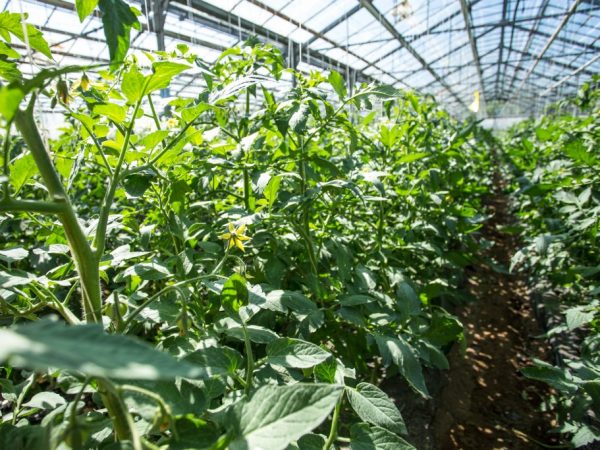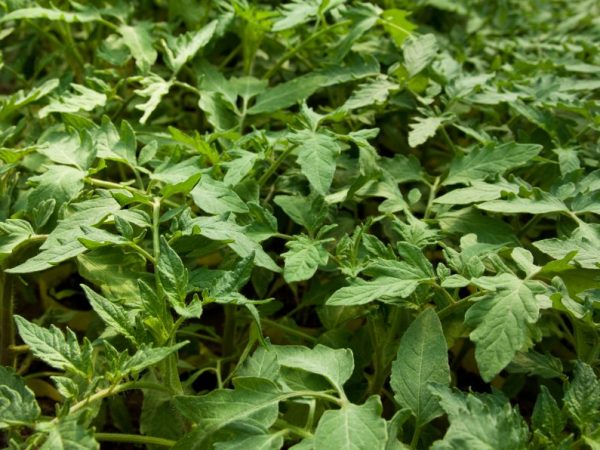Why tomatoes are fattened
When growing tomatoes, you can face a number of problems. One of them is fatliquoring. When tomatoes are fattened, the plant grows, and the fruits cannot reach normal size.

Reasons for fattening tomatoes
External manifestations of fattening
The fattening of tomatoes can occur both in the greenhouse and in the open field.
Tatiana Orlova (Candidate of Agricultural Sciences):
This phenomenon should be feared only by gardeners in the more northern regions of the country, where the growing season is short. In the southern regions, farmers deliberately "accelerate" the growth of tomatoes at the initial stage, because in the future all this vegetative mass of plants will work for the harvest.
Fatting means that the tomato is saturated with micro- and macroelements that ensure the growth of the plant itself. Such a bush immediately attracts attention with a developed and juicy stem, large brightly colored leaves. But the lack of substances responsible for fruiting does not allow large fruits to grow and ripen.
- The most susceptible to fattening are tall, indeterminate varieties. Tomato brushes are tied along the entire length of the high stem. Medium and undersized varieties almost never suffer from this problem.
- In the open field, during the flowering of the tomato, another shoot begins to grow from the very top. The plant gets entangled with the neighbors, forming a kind of ball.
- In hotbeds and greenhouses, fattening looks something like this: the upper leaves are curled, but the plant remains strong. There are many leaves on it, new shoots are tied, especially at the top of the bush. There are many fruits, but they are all small and do not blush.
Reasons for fattening
Improper care of tomatoes and their seedlings can cause fattening.
Major mistakes:
- Excessive amount of dressing. Do not get too carried away with fertilizing, especially nitrogen. It is also important to monitor the amount of chicken droppings in the soil. Both fertilizers stimulate an increase in the above-ground mass, but this has a negative effect, due to which the tomato is significantly weakened. As a result, it cannot produce a good harvest and is prone to disease. He spends the energy necessary for the growth of fruits on unnecessary new shoots.
- Tomatoes are fattening due to excessively moist soil. Watering too often, especially in the first months after planting, interferes with the development of the fruit. This reduces resistance to diseases and parasites, and can also lead to rotting of fruits, the appearance of slugs.
- Lack of light. In greenhouse conditions, it is difficult to regulate the illumination, but you need to worry about this even before planting the tomatoes. On the open ground, it is harmful to plant several bushes next to it. The optimal distance is 30 cm between the bushes, otherwise, growing up, the roots are woven into a solid ball. The sun's rays do not reach there, and excess moisture is retained in the soil. This complicates the process of harvesting and caring for the beds.
Tatiana Orlova (Candidate of Agricultural Sciences):
The introduction of a large amount of nitrogen fertilizers is fraught not only with the fact that the plants form a large aboveground mass and fruiting is delayed, but also with the fact that nitrogen in the soil solution displaces calcium, which becomes inaccessible to tomato plants. As a result, the fruits of such plants are affected by apical rot, and the plants themselves are poorly resistant to fungal and bacterial infections.
Troubleshooting methods
If the tomatoes are already fat, you should act immediately, otherwise the crop may not ripen, and in the best case, you can get pea-sized tomatoes.
Temperature
Adjust humidity and temperature. It is best not to water the plant for 7-10 days after the problem has been noticed. In the future, it is worth dosing water and controlling soil moisture.
It is difficult to regulate the temperature outdoors. If it is above 25 ° C, it is worth tying up each bush and not letting them intertwine. If the weather is chilly, it is best not to do this.

It is worth maintaining the optimal temperature in the greenhouse.
To reduce the temperature in the greenhouse, all windows and doors are opened. You can even remove some of the frames or some of the film. If the temperature is below 24 ° C, everything is closed, trying to keep the remaining heat.
Top dressing
The second step in the fight against fattening is proper feeding and fertilization. Phosphate fertilizers help to normalize the soil where the fattening tomatoes grow. To balance the ph of the soil, root top dressing is performed with a solution of magnesium sulfate.
An excellent solution to the problem is root feeding with a solution of an extract from superphosphate. Add 3 tbsp. To a bucket of warm water. l. superphosphate. The mixture is poured directly under the root of the affected tomato bushes.
Topping
In the fight against the problem, pinch off the shoots that grow after the flower or fruit. This is how the tomato physically stops growing. This makes the plant stronger and more capable of fruiting quality.
Prophylaxis
Prevention of fattening is carried out even before planting the seeds.
Treatments to prevent fattening
- The choice of the variety. De-Barao, King of large, Galina F1 fatten more often, and in case of illness they give very small fruits (weighing up to 20-30 g). It is better to choose medium-sized or undersized varieties.
- Landing site. This should not be a low-lying area or a place where water collects. It is also worth paying attention to the movement of air at the landing site (are there any nearby buildings that impede the free circulation of air masses).
- Land preparation. It is necessary to prepare the soil in the fall. It is dug up, disinfected and fertilized to balance the beneficial elements.
- Planting seedlings in the ground. Tomatoes are planted at a distance of 30-40 cm, between the beds - 70-80 cm. This prevents the plants from quickly intertwining, simplifies care and harvesting.
- Fertilizing and feeding. When growing seedlings, you do not need to get too carried away with growth stimulants and nitrogen fertilizers.
Tatiana Orlova (Candidate of Agricultural Sciences):
In indeterminate varieties, one of the important techniques that prevent overgrowth of plants is its correct formation - the timely removal of unnecessary stepsons. And in varieties of carpal tomatoes, which can lay up to 8-10 fruits in the brush, rationing of the ovary is pinching the end of the brush so that the remaining fruits can ripen in time.
Preventive examination is very important. You should often inspect the area where tomatoes are planted: this way you can prevent not only fattening, but also other diseases of tomatoes. This can be done at harvest, but not more often than once every 3 days.
Conclusion
The fattening of tomatoes can not be noticed immediately: outwardly, the bushes are healthy, the leaves and stems are developed. It is important to carry out a thorough preventive examination in order to determine as early as possible that the tomatoes are getting fat. The main consequence of this process is a poor quality crop.



